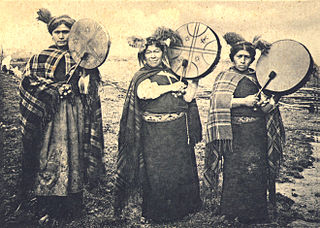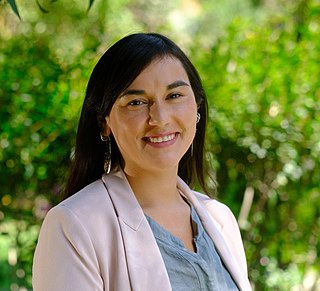Related Research Articles

The Mapuche are a group of indigenous inhabitants of south-central Chile and southwestern Argentina, including parts of Patagonia. Originally from the forests of the southern Andes, Mapuche people lived in the woods as "horticulturalists”. Mapuche populations shifted towards Argentina and Chile in the sixteenth century. The collective term refers to a wide-ranging ethnicity composed of various groups who shared a common social, religious, and economic structure, as well as a common linguistic heritage as Mapudungun speakers. Their homelands once extended from Aconcagua Valley to Chiloé Archipelago and later spread eastward to Puelmapu, a land comprising part of the Argentine pampa and Patagonia. Today the collective group makes up over 80% of the indigenous peoples in Chile, and about 9% of the total Chilean population. The Mapuche are particularly concentrated in the Araucanía region. Many have migrated from rural areas to the cities of Santiago and Buenos Aires for economic opportunities.

The Araucanía, La Araucanía Region is one of Chile's 16 first-order administrative divisions, and comprises two provinces: Malleco in the north and Cautín in the south. Its capital and largest city is Temuco; other important cities include Angol and Villarrica.

Cañete is a city and commune in Chile, located in the Arauco Province of the Biobío Region. It is located 135 km to the south of Concepción. Cañete is known as a "Historic City" as it is one of the oldest cities in the country. The Battle of Tucapel and Pedro de Valdivia's death happened near the city's current location. Cañete was also an important location in the Arauco War.

The mythology and religion of the indigenous Mapuche people of south-central Chile and southwestern Argentina is an extensive and ancient belief system, a series of unique legends and myths are common to the various groups that make up the Mapuche people. These myths tell of the creation of the world and the various deities and spirits that reside in it.
Cuncos or Juncos is a poorly known subgroup of Huilliche people native to coastal areas of southern Chile and the nearby inland. Mostly a historic term, Cuncos are chiefly known for their long-running conflict with the Spanish during the colonial era of Chilean history.

Coordinadora Arauco-Malleco (CAM) is a radical, militant indigenous organization engaged in political violence in pursuit of attaining an autonomous Mapuche state in the territory they describe as Wallmapu.
The Mapuche conflict involves indigenous Mapuche communities located in Araucanía and nearby regions of Chile and Argentina. It is often referred to as a conflict between the Mapuche and the Chilean government or state. Big forestry companies and their contractors, Chilean police and some non-indigenous landowners have been confronted by militant Mapuche organizations and local Mapuche communities in the context of the conflict. Some scholars argue the conflict is an indigenous self-determination conflict, others like Francisco Huenchumilla see it as the expression of a wider political conflict that affects all of Chile given the existence of other indigenous groups.

CMPC is a Chilean pulp and paper company, being the biggest worldwide according Forbes Global 2000 2018 ranking. It is engaged in integrated forest industry, which operates as a holding company through four business centers: Forestry, Pulp, Paper and Paper Products, and Tissue. Each of these areas can function independently, being in the holding company for overall coordination and financial management of these businesses. Supplies, computer systems and other related administrative support, are centralized in CMPC SA Shared Services.

Forestry is one of the main economic sectors of Chile, representing 14% of the value of the country's total exports. This places the forestry sector in Chile as the second largest export sector behind copper mining. From 1970 to 2005 planted forest surface in Chile grew from 300,000 ha to more than 2.07 million ha. In 2019 Chile had slighly more than 2,3 million ha of forest plantations of which 1,3 million ha were Pinus radiata and 0,9 million ha were of Eucalyptus globulus and Eucalyptus nitens. In 2006 70% of Chile's forestry production went to export, and the industry employed more than 150,000 workers. By 2020 people employed in the sector were down to 112,200.
From 1850 to 1875, some 6,000 German immigrants settled in the region around Valdivia, Osorno and Llanquihue in Southern Chile as part of a state-led colonization scheme. Some of these immigrants had left Europe in the aftermath of the German revolutions of 1848–49. They brought skills and assets as artisans, farmers and merchants to Chile, contributing to the nascent country's economic and industrial development.
As an archaeological culture, the Mapuche people of southern Chile and Argentina have a long history which dates back to 600–500 BC. The Mapuche society underwent great transformations after Spanish contact in the mid–16th century. These changes included the adoption of Old World crops and animals and the onset of a rich Spanish–Mapuche trade in La Frontera and Valdivia. Despite these contacts Mapuche were never completely subjugated by the Spanish Empire. Between the 18th and 19th century Mapuche culture and people spread eastwards into the Pampas and the Patagonian plains. This vast new territory allowed Mapuche groups to control a substantial part of the salt and cattle trade in the Southern Cone.

Camilo Marcelo Catrillanca Marín was a Mapuche farmer from Temucuicui in Chile who was shot to death by the Chilean police force under suspicious circumstances. The incident led to protests against police violence, and occurred in the broader context of the ongoing conflict over Mapuche civil rights.
Temucuicui or Temocuicui is a locality made up a group of Mapuche communities in the commune of Ercilla, Malleco Province, Araucanía Region, in Chile.

Weichán Auka Mapu (WAM) is a Mapuche armed and revolutionary organization that operates mainly in southern Chile, being a supporter of armed struggle through arson attacks, sabotage actions and clashes with firearms against police officers, in order to achieve authentic autonomy for the Mapuche people.

Among the indigenous Mapuche people of Chile, there is those that practise traditional polygamy. In modern Chile polygamy has no legal recognition. This puts women whose marriages to their husbands are not legally recognized at a disadvantage to the legal wife who is in terms of securing inheritance. Polygamy is much less common today, particularly in comparison with the time preceding the Occupation of Araucanía (1861–1883), when the traditional Mapuche homeland was finally brought under control of the Chilean government. It survives as a chiefly rural practice, but has also been reported in the low-income peripheral communities of Santiago. Wives who share the same husband are often relatives, such as sisters, who live in the same community. According to folklore, polyandry among the Mapuche is reputed to exist at least historically, in which case the husbands may have been brothers, but no documentation exists attesting to this phenomenon. It is also in contradiction to the renewal of the warrior ethos (weichan) promoted by militant organizations such as Coordinadora Arauco-Malleco.

Izkia Jasvin Siches Pastén is a Chilean physician and politician, who served in 2022 as Minister of Interior and Public Security for President Gabriel Boric. She was the first woman to hold that position, the second most important in government after the President.

Francisca Linconao Huircapán, also known as Machi Linconao, is a machi and human rights activist in Chile. She became the first Indigenous rights defender in Chile to successfully invoke the 1989 Indigenous and Tribal Peoples Convention when she sued to stop a company from logging a forest adjacent to her community. In 2021, she was elected as a representative of the Mapuche people to the Chilean Constitutional Convention election.

Natividad Llanquileo Pilquimán is a Mapuche lawyer and human rights activist. Llanquileo was noted for her role as a spokesperson during the 2010 Mapuche hunger strike.
Alexis Reinaldo Caiguan Ancapan is a Mapuche-Huilliche educator, musician, and politician in Chile. In 2021, Caiguan was elected to serve as a member of the Constitutional Convention of Chile to represent the Mapuche people in the Los Lagos Region.

Wallmapu is a name for the traditional territory and historical country of the Mapuche people of southern South America. The term was coined in the early 1990s by Indigenist groups but gained traction in the 2000s as the Mapuche conflict in Araucanía intensified. Some view the Wallmapu as being composed of two main parts Ngulumapu in the west and Puelmapu in the east, with the southern part of Ngulumapu being known as Futahuillimapu.
References
- ↑ "Harmoniously developing forestry practices". cmpcmaderas.com (in Spanish). Retrieved 2022-04-02.
- ↑ Rodríguez, Sergio (December 8, 2013). "Temucuicui, la comunidad que vive en alerta". La Tercera (in Spanish). Retrieved April 16, 2017.
- ↑ Nahuelpán, Héctor; Martínez, Edgars; Hofflinger, Alvaro; Millalén, Pablo (2021-08-19). "In Wallmapu, Colonialism and Capitalism Realign". NACLA Report on the Americas . Routledge (3). doi:10.1080/10714839.2021.1961469.